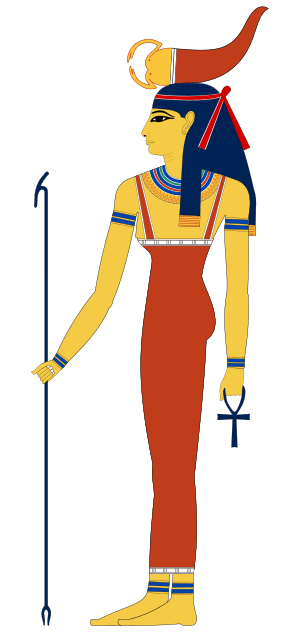Serket facts for kids
Serket was an important ancient Egyptian goddess. People believed she had special powers. She was often shown as a scorpion or as a woman with a scorpion on her head.
Ancient Egyptians thought Serket could sting "bad" people. But she was also known for her ability to heal. She could cure scorpion stings and other poisons, like snake bites. Because she could heal snake bites, Serket was sometimes seen as a protector from Apep. Apep was an evil snake-god in Egyptian myths.
Contents
Who Was Serket?
Serket was a goddess linked to healing and protection. Her name means "she who causes the throat to breathe." This refers to her power to heal stings and bites. These could make it hard to breathe. She was a very old goddess, worshipped even before the pharaohs ruled Egypt.
Serket's Appearance
Serket was usually shown in two main ways. She could be a full scorpion, ready to sting. More often, she was shown as a woman. This woman would have a scorpion on her head. Sometimes, the scorpion would have its tail raised, ready to strike.
Worship and Priests
Serket did not have large temples built just for her. However, she had many priests who served her. These priests were often healers themselves. They used their knowledge of medicine and magic to help people. They would pray to Serket for protection and healing.
Serket and the Dead
Many people in ancient Egypt died from bites of poisonous animals. Because of this, Serket also became known as a protector of the dead. She was thought to guard people on their journey to the afterlife.
Protecting Embalmers
Serket was connected to the process of embalming. This was how ancient Egyptians prepared bodies for burial. She was linked to the fluids that caused bodies to stiffen. This made her a protector of the tents where embalmers worked.
Guardian of Canopic Jars
Serket was also a guardian of the canopic jars. These jars held the internal organs of the deceased. Each jar was protected by one of the Four sons of Horus. Serket was especially linked to the jar holding the intestines. This jar was guarded by Qebehsenuf. The intestines were thought to be connected to poisons.
Serket's Connections to Other Gods
Because she protected canopic jars, Serket was often associated with other goddesses. These included Aset (Isis), Nebet Het (Nephthys), and Neith. These four goddesses often worked together in myths. They helped protect the dead and their organs.
Over time, Serket's role changed. She began to be seen as part of the goddess Isis. Instead of being a separate goddess, Serket became known as one aspect of Isis. This shows how Egyptian gods and their stories could change over many centuries.
Images for kids
-
Serket and her scorpion, Edfu Temple
See also
 In Spanish: Serket para niños
In Spanish: Serket para niños





